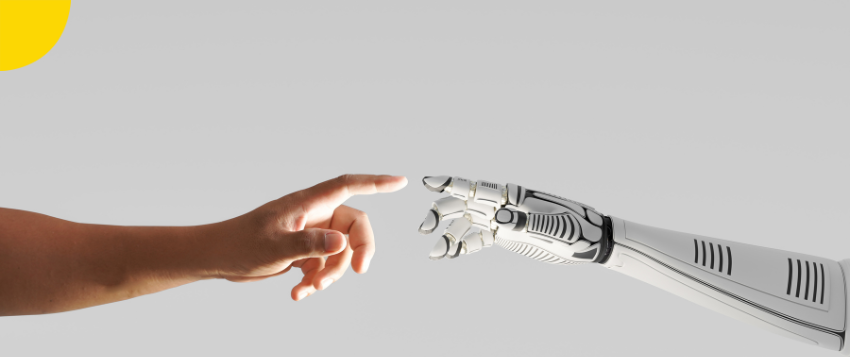Design thinking can be a powerful approach to harness the potential of artificial intelligence (AI) in an AI-driven world. It helps in understanding user needs, generating innovative ideas, and creating user-centred AI solutions.
In this article, we will delve into the concept of design thinking, its significance in conjunction with AI, and the successful utilisation of this approach by various companies. We will explore how design thinking can be applied in an AI-driven world and examine the valuable lessons we can glean from these experiences.
Design thinking is a problem-solving approach that focuses on understanding and meeting the needs of consumers. It involves observing how people interact with their surroundings with empathy and using a hands-on process to come up with creative solutions. Design thinking has gained momentum in recent years as a problem-solving approach, with increasing interest in its application to tackle complex issues. It is a sought-after skill that revolves around understanding and addressing consumer needs.
The core principles of design thinking typically include five stages: empathise, define, prototype, ideate, and test. Let’s discuss these stages in more detail:
Design Thinking Stages
- Empathise
Imagine stepping into someone else’s shoes and seeing the world through their eyes. That’s exactly what empathising is all about. In the context of design thinking, empathising means understanding the needs, desires, and challenges of the people who will ultimately use AI technology. It involves actively listening, observing, and engaging with users to gain deep insights into their experiences, emotions, and aspirations. Empathy allows designers to uncover valuable information that forms the foundation for creating AI solutions that truly address users’ needs and improve their lives.
- Define
Once you have a strong sense of empathy and a wealth of user insights, it’s time to define the problem you’re aiming to solve. The “define” stage helps you narrow down your focus and establish a clear problem statement. It’s like navigating through a maze and finding the right path. Here, you analyse and synthesise all the information gathered during the empathise stage to identify the core challenges that your AI technology should tackle. Defining the problem is crucial because it sets the direction for the rest of the design process and ensures that your efforts are purposeful and impactful.
- Prototype
Imagine you’re an inventor, bringing your wildest ideas to life. That’s exactly what prototyping is all about – transforming abstract concepts into tangible representations. In the context of design thinking and AI, prototyping involves creating simplified versions or mock-ups of your AI technology. These prototypes can take various forms, from simple sketches or wireframes to interactive digital models. By prototyping, you can quickly iterate, experiment, and gather feedback on your ideas. It’s a hands-on approach that allows you to test different solutions, refine them, and visualise how the AI technology will function in the real world.
- Ideate
Here you let your imagination run wild to unlock your creativity – that’s what ideation is all about. This stage is like a brainstorming bonanza, where you generate a multitude of ideas and explore countless possibilities. In design thinking, ideation encourages a free flow of thoughts, without judgment or limitations. It’s the moment to think big, challenge assumptions, and come up with innovative approaches to solve the defined problem. Ideation can involve individual brainstorming, group workshops, or even drawing inspiration from other industries. The goal is to foster a creative environment that sparks breakthrough ideas and uncovers new perspectives for your AI technology.
- Test
Now it’s time to put your AI solution to the ultimate test – the test stage! Think of it as a science experiment where you carefully observe and evaluate the performance of your technology. Testing involves gathering feedback from real users and analysing their reactions and experiences. By observing how people interact with your AI system, you can identify its strengths, weaknesses, opportunities, and threats (SWOT analysis), allowing you to pinpoint areas for improvement. Testing is an iterative process, allowing you to refine and enhance your technology based on user insights. It helps ensure that your AI solution meets user expectations, functions seamlessly, and delivers the intended benefits.
This problem-solving approach involves a hands-on and iterative process. It encourages one to step into the shoes of the users, empathise with their needs, and deeply understand their pain points. Through research, interviews, and observation, organisations can gather valuable information that helps them define the core problem or challenge to be addressed.
Design thinking can play a significant role in the development and application of AI technologies. When it comes to AI, design thinking can help ensure that the technology is not only technically proficient but also user-centred and ethically aligned.
How to Use Design Thinking in an AI-Driven World?
AI and design thinking are tools we can leverage today to make well-informed decisions about people’s needs in their lives through data analysis. Design thinking, with its customer-centric approach, and AI, with its human-like intelligence systems, both aim to solve problems for everyone.
Let’s take a look at how some leading companies have succeeded in using design thinking and AI interchangeably:
- Flatpack Couch by Ikea

Who would’ve thought a couch could fit into an envelope? Space10, the Copenhagen-based independent research and design lab behind the project, in collaboration with Swiss design firm Panter&Tourron and through the use of generative artificial intelligence, a flat-pack couch prototype was created. The idea came about when the Swedish giant Ikea wanted to create an affordable, high-quality, easy-to-ship furniture. The project was originally an exploration of the potential for using digital-fabrication tools like 3D-knitting robots to create lightweight and foldable furniture.
This remarkable project demonstrates how the combination of AI and design thinking can address customer demands for affordable and easily transportable furniture. By leveraging AI-generated ideas and incorporating human expertise, Space10 successfully created a flatpack couch prototype that meets these requirements while pushing the boundaries of innovative design.
For more detailed info on this, click here.
- Nest Thermostat by Google
Nest Thermostat is a smart home device that uses AI algorithms to learn user preferences and adjust temperature settings accordingly. It applies design thinking principles to create a simple and intuitive user interface, allowing users to control and customise their home climate easily.
- Spotify’s Discover Weekly
Spotify’s Discover Weekly playlist is a personalised recommendation feature that uses AI algorithms to analyse users’ listening habits and provide them with a curated playlist of new and relevant music every week. They created a seamless and enjoyable user experience, making it easy for users to discover new music that aligns with their tastes.
- IBM Watson
IBM Watson is an AI-powered platform that utilises natural language processing and machine learning algorithms to analyse vast amounts of data and provide insights for various industries such as healthcare, finance, and customer service. IBM used design thinking principles to ensure the platform’s usability and to enable users to interact with complex AI capabilities more intuitively.
- Amazon Echo
Amazon Echo, powered by the AI assistant Alexa, utilises natural language processing and machine learning algorithms to provide a range of voice-activated services. The principles of design thinking helped create a user-friendly and intuitive interaction model, making it effortless for users to access information, control smart home devices, and enjoy entertainment.
These products are just examples of how companies incorporated AI with Design Thinking. The possibilities are endless as we get deeper into the 5th industrial revolution.
- Strategic Leadership to Combat Social Engineering Threats - April 18, 2024
- The Essence of Leadership: Empowerment Over Authority - April 4, 2024
- The DevinAI Impact: A Leader’s Guide - March 21, 2024







